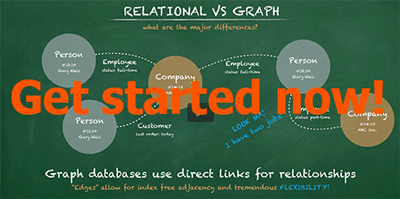Running OrientDB the First Time
With a master-slave architecture, the master often becomes the bottleneck. With OrientDB, throughput is not limited by a single server. Global throughput is the sum of the throughput of all the servers.
- First, download and extract OrientDB by selecting the appropriate package provided in our download page(click here for additional installation methods).
- Start the server by running the server.sh or server.bat scripts located in the bin folder.
- Once OrientDB is running, enter the following URL in a browser window: http://localhost:2480. This is Studio, the most advanced Web tool for Databases.
If you’re new to OrientDB, we recommend taking a look at the following links:
Learning Objectives
- Install OrientDB and create a new database
- Learn the differences between Relational and Graph models
- Build a flexible Graph and Document data model
- Implement most major SQL functions, including basic CRUD operations
- Deploy and mange a production application
Take Our Free Course
Here at OrientDB, we believe the future of Data requires a multi-model database because of its infinite power and flexibility. We know that after more than 30 yrs of Relational DBMSs, it can be challenging at first using innovative technology like OrientDB. So, we decided to provide a Getting Started video course for FREE. This course is designed to help developers become productive and familiar with OrientDB and related tools in the fastest way possible. More than 19,000 people already joined the course.
Section A: First Steps
- 1: Background and Concepts
- 2: Up and Running
- 3: Data Modelling Concepts
- 4: OrientDB Studio
- 5: OrientDB Console
Section B: Working with the Database (SQL API)
- 6: SQL API Overview
- 7: Data Modelling (SQL)
- 8: Basic CRUD (SQL)
- 9: Graph Functionality and Traversals (SQL)
- 10: Transactions
Section C: Additional Features
- 11: Server Side Functions
- 12: User Permissions and Authentication
- 13: REST / HTTP API
- 14: Basics of a Distributed Deployment
- 15: ETL Module
- 16: Building the VehicleHistoryGraph Database
- 17: Working with the Demo Database
Section D: OrientDB Professional Services
- 18: OrientDB Enterprise with Workbench
- 19: Orient Technologies Support & Consulting Services
Start now!
Begin the course by following these 2 simple steps:
Access the OrientDB - Getting Started course.
Enter your email and a name/password of your choosing to register with Udemy.com,
if you do not already have an account.





